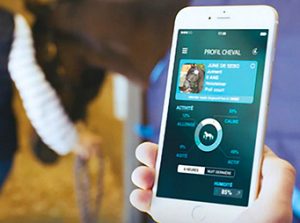Smart Technology Enters the Equine Arena
Click here to read the complete article290 – July/Aug, 2018
BY MEGAN ULRICH
 These days, it seems that technology affects every area of our lives. From the blue-tooth-enabled coffee maker that can brew a cup of joe at your preferred temperature to a robotic vacuum that automatically navigates your home with ease, smart devices are highly sought after for convenience, time saving, and the just plain cool factor!
These days, it seems that technology affects every area of our lives. From the blue-tooth-enabled coffee maker that can brew a cup of joe at your preferred temperature to a robotic vacuum that automatically navigates your home with ease, smart devices are highly sought after for convenience, time saving, and the just plain cool factor!
One area that’s dominated by smart devices is the health and fitness industry. There are traditional fitness devices like the Fitbit that monitors your heart rate, pace of exercise, and number of steps taken or the Garmin watch that can track your run with GPS capabilities. Then, there are those that sound like they’re out of a science fiction movie. For example, the Cue identifies levels of testosterone, Vitamin D, and fertility hormone with small amounts of blood or saliva and connects to your phone. The Vessyl Cup analyzes the liquids you drink and tells you the dietary contents of your beverage, like sugar, starch, and caffeine level.
Of course, it didn’t take long for this trend to cross over into the horse world. In fact, some 80 companies now provide wearable sensor technology for horses, boasting data collection like real-time calories burned or post-workout training summaries. From smart halters and saddles to safety devices, these gadgets span the spectrum.
Gait Analysis With a ‘Smart Girth’
The Seaver Anatomical Girth allows riders to monitor their horse’s performance and physical condition in real time during training sessions and access a detailed post-training summary of additional data regarding movements, especially those associated with Jumping.
Zakaria Antar, CEO and co-founder of Seaver, is a former semi-professional rider, who came up with the idea of creating a technology that would provide feedback on his training sessions after his own frustration with finding no precise and scientific way to measure his progress. The resulting technology in the Seaver Anatomical Girth displays speed, calories burned, heart rate, distance covered, and training duration in real time. The complete analysis of the session, which is available post-exercise, includes gait analysis, locomotion analysis (like pace, elevation, and symmetry), anomalies in stride (such as potential lameness or abscesses), maximum and average speed, and effort analysis. The jump analysis feature includes information on a horse’s fence approach, distance, strides, height, parabola, strike force, and a map view of the course.
Click here to read the complete article290 – July/Aug, 2018










